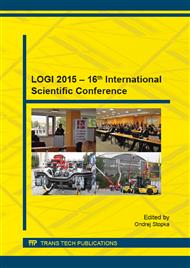[1]
M. Kendra, M. Babin, D. Barta, Changes of the infrastructure and operation parameters of a railway line and their impact to the track capacity and the volume of transported goods, In: Procedia - social and behavioral sciences, Vol. 48 (2012).
DOI: 10.1016/j.sbspro.2012.06.1052
Google Scholar
[2]
O. Stopka, L. Bartuska, I. Kubasakova, Selecting the Most Suitable Region in the Selected Country for the Placement of the Bi-Modal Freight Village Using the WSA Method, In: Scientific proceeding for the conference ITELMS'2014, Kaunas, Litva, (2014).
Google Scholar
[3]
I. Kubasakova, R. Kampf, O. Stopka, Logistics information and communication technology, In: Communications, Vol. 16, No. 2 (2014) 9-13.
Google Scholar
[4]
A. Tuzar, O. Pastor, Transport systems theory, ASPI, Praha, (2007).
Google Scholar
[5]
J. Gasparik, J. Siroky, L. Peceny, M. Halas, Methodology for assessing the quality of rail connections on the network, In: Communications: scientific letters of the University of Zilina, Vol. 16, No. 2 (2014) 25-30.
DOI: 10.26552/com.c.2014.2.25-30
Google Scholar
[6]
P. Ficzere, Z. Ultmann, A. Toeroek, Time – space analysis of transport system using different mapping methods, In: Transport, Vol. 29, No. 3 (2014) 278-284.
DOI: 10.3846/16484142.2014.916747
Google Scholar
[7]
L. Maskeliunaite, H. Sivilevicius, Expert evaluation of criteria describing the quality of travelling by international passenger train: technological, economic and safety perspectives, In: Technological and economic development of economy, Vol. 18, No. 3 (2012).
DOI: 10.3846/20294913.2012.710178
Google Scholar
[8]
G. Fedorko, M. Weiszer, Configuring the parameters of multi-objective evolutionary algorithm for integrated timetabling and vehicle scheduling in public transport, in: Congr. Proc. - CLC 2012 Carpathian Logist. Congr., 2012, pp.435-440.
Google Scholar
[9]
S. Krile, D. Zagar, G. Martinovic, Better Bandwidth Utilization of Multiple Link Capacities with Mutual Traffic Correlation, Tehnicki vjesnik - Technical Gazette, Vol. 16, No. 4 (2009) 11-18.
Google Scholar


